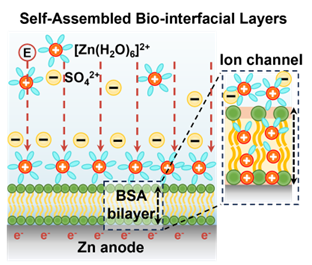Aqueous Zinc-ion (Zn-ion) batteries have attracted significant attention recently as viable alternatives for energy storage systems. Distinct from conventional lithium and sodium-based rechargeable batteries, Zn-ion batteries employ non-toxic aqueous electrolytes and abundant Zn metal, highlighting their advantages in safety, environmental protection, and sustainability for grid-scale applications. In addition, the Zn metal anode has a high theoretical capacity of 820 mAh g-1 and a relatively low electrode potential (−0.76 V vs. standard hydrogen electrode). However, despite the above-mentioned advanced characteristics, the widespread implementation of Zn-ion batteries is facing significant challenges, most of which are related to the poor electrochemical performance of Zn metal anodes. The first issue is the formation of dendrites during repeated Zn plating/stripping processes, leading to short circuits and failure of batteries. Meanwhile, the Zn anode is susceptible to corrosion and generates byproducts (e.g., Zn4SO4(OH)6·xH2O). These inactive byproducts accumulate on the surface of the Zn anode and obstruct Zn2+ ion transfer, severely intensifying surficial passivation and reducing the battery’s cycling stability.
This study investigated BSA as an electrolyte additive to construct an interfacial layer on Zn metal anodes via a self-assembly process for dendrite-free Zn metal anodes. BSA molecules form a complex bilayer structure on the Zn anode, featuring a hydrophilic outer layer and a hydrophobic inner layer, which is crucial in optimizing Zn ion migration and desolvation processes. The hydrophilic outer layer effectively reduces the activity of interfacial water molecules, while the hydrophobic inner layer blocks the intrusion of solvated water molecules, promoting the desolvation of [Zn(H2O)6]2+ and reducing direct contact between water molecules and the Zn anode. This unique mechanism effectively suppresses the formation of Zn dendrites and significantly reduces the generation of by-products. Using Cryo-EM and XPS etching techniques, we successfully observed and confirmed the existence and detailed composition of the BSA bilayer on the Zn metal anode. In addition, the AIMD simulation and DFT calculation confirm that BSA can enhance the desolvation process of Zn2+ at the Zn anode by modifying the electrolyte's solvation structure, hence improving deposition efficiency by directing Zn2+ deposition on the Zn (002) plane. Electrochemical characterization results highlighted the significant contribution of the BSA bilayer in enhancing the cycling stability of Zn||Zn symmetric cells, Zn||Cu half-cells, and Zn||V2O5 full cells. Notably, the Zn||Zn battery demonstrated stable cycling performance for 2400 hours at a current density of 10 mA cm−2 and a capacity limitation of 1 mAh cm−2. Moreover, the Zn||V2O5 battery maintained a high specific capacity of 95 mAh g−1 after 4800 cycles at a high current density of 5 A g−1. This study opens a new avenue for developing safe, dendrite-free, high-energy density Zn metal anodes for Zn-ion batteries.

Recently, Tianyi Wang, Huan Pang, Chengyin Wang from Yangzhou University, and Bing Sun, Guoxiu Wang from the University of Technology Sydney have significantly enhanced the performance of aqueous zinc-ion batteries by leveraging the self-assembly of bovine serum albumin (BSA) into a bilayer structure on zinc metal anodes. The study reveals that the hydrophilic and hydrophobic fragments of BSA create unique and intelligent ion channels, regulating zinc ion migration and facilitating the desolvation process. This approach significantly reduces parasitic reactions on the zinc anode, achieving uniform deposition on the Zn (002) plane. Consequently, Zn||Zn symmetric cells with BSA as an electrolyte additive demonstrated remarkable cycling stability, lasting up to 2400 hours at a high current density of 10 mA cm-2. This research underscores the critical role of self-assembled protein bilayers in enhancing the durability of zinc anodes in aqueous zinc-ion batteries. The related paper, titled "Multifunctional Self-Assembled Bio-Interfacial Layers for High-Performance Zinc Metal Anode," has been published in Angewandte Chemie International Edition (Impact Factor 16.6). Jiahui Lu is the first author, with Associate Professor Tianyi Wang, Dr. Bing Sun, Professor Guoxiu Wang, and Professor Chengyin Wang as corresponding authors.
Article information:
Jiahui Lu, Tianyi Wang*, Jian Yang, Xin Shen, Huan Pang, Bing Sun*, Guoxiu Wang*, Chengyin Wang*, Multifunctional Self-Assembled Bio-Interfacial Layers for HighPerformance Zinc Metal Anodes. Angewandte Chemie International Edition, 2024, e202409838 (DOI: 10.1002/anie.202409838)
Paper link: https://onlinelibrary.wiley.com/doi/10.1002/anie.202409838

